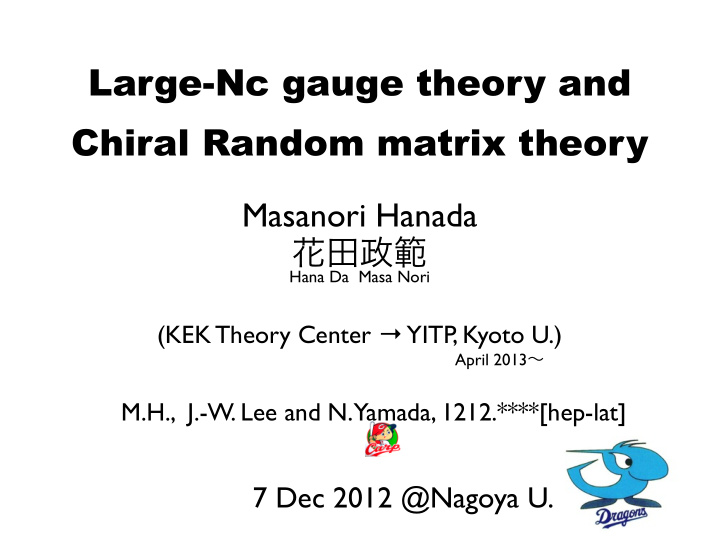



花田政範 Large-Nc gauge theory and Chiral Random matrix theory Masanori Hanada Hana Da Masa Nori (KEK Theory Center → YITP , Kyoto U.) April 2013 ~ M.H., J.-W. Lee and N. Yamada, 1212.****[hep-lat] 7 Dec 2012 @Nagoya U.
SU( ∞ ), V= ∞ gauge theory with Nf=2 adjoint fermions conformal? confining? ( ※ other repsensations are also possible) chiral symmetry breaking? Large-Nc equivalence (Eguchi-Kawai equivalence) in the ’t Hooft limit SU( ∞ ), finite-V gauge theory Study this theory (Eguchi-Kawai model) V= ∞ instead of Earlier work: Narayanan-Neuberger, (V=2^4 in our simulation) Hietanen-Narayanan, Gonzalez-Arroyo-Okawa, etc ※ To establish the method, we numerically study Nf=0 case, for which we know the answer.
Chiral Random Matrix Theory (chi-RMT) QCD and chi-RMT give the same Dirac spectrum SU(3) QCD N × N complex L >> 1/ Λ QCD matrix V ⇔ N Chiral Perturbation Theory ε -regime (L<<1/m π ), m q V Σ : fixed, V →∞ chi-RMT m q N : fixed, N →∞
Chiral Random Matrix Theory (chi-RMT) QCD-like theory (YM + fermion) if the chiral sym. L >> 1/ Λ QCD breaking is broken Chiral Perturbation Theory ε -regime (L<<1/m π ), m q V Σ : fixed, V →∞ chi-RMT (3 classes depending on the chiral symmetry breaking pattern) The Dirac spectrum coincide if the chiral symmetry is spontaneously broken.
Large-Nc vs chi-RMT V →∞ . • In QCD, thermodynamic limit is V →∞ and/or Nc →∞ . • In the SU(Nc) case, it is So, when we compare it with chi-RMT, V × (Nc) α ⇔ N Σ ~ (Nc) α m q V × (Nc) α : fixed. ( α > 0) Let us call it as ‘chi-RMT limit.’
Large-Nc vs chi-RMT The large-Nc ’t Hooft limit and chi-RMT limit are different! V : fix, Nc →∞ ’t Hooft limit (planar limit) : m q , chi-RMT limit : m q V × (Nc) α fixed, Nc →∞ The Eguchi-Kawai equivalence does not hold in the chi-RMT limit! ( ※ m q =0 should be regarded as the chi-RMT limit.)
Large-Nc vs chi-RMT The large-Nc ’t Hooft limit and chi-RMT limit are different! ‘t Hooft counting holds when this coefficient is Nc-independent
Large-Nc vs chi-RMT QCD (SU(3)) V →∞ agreement with chi-RMT @ mV fixed, nonzero chiral condensate @ m → 0 after V →∞ large-Nc YM agreement with chi-RMT @ mV × (Nc) α fixed, Nc →∞ nonzero chiral condensate @ m → 0 after Nc →∞ ‘t Hooft limit
Large-Nc vs chi-RMT This argument might be too naive for the Eguchi-Kawai model, because the chiral perturbation might not be applicable to 2^4 lattice straightforwardly. Still, however: • For sufficiently large lattice, there is no problem. There, the eigenvalue distribution depends only on mV × (Nc) α . • If there is no phase transition (center symmetry breaking), the same expression should hold even at small V.
Numerical results (Nf=0) •2^4 plaquette action + heavy Dirac adjoint fermion → unbroken center symmetry • Probe massless overlap fermion in the adjoint representation • Low-lying Dirac eigenvalues scales as 1/Nc → α =1 (Naive expectation from the ‘t Hooft counting is α =2) • Chiral symmetry must be broken. Can we detect it by comparing the simulation data with the chi-RMT prediction?
Numerical results (Nf=0) 2^4 lattice good convergence δλ k = < Im[ λ k - λ k-1 ] > , δλ 1 = < λ 1 >
Numerical results (Nf=0) 1/Nc correction chi-RMT 2^4 lattice SU(16) perfect agreement with chi-RMT!
Conclusion & Outlook • Chiral symmetry breaking at large-Nc can be detected by comparing small-size lattice and chi-RMT. • 2^4, SU(8) (or SU(16)) is good enough. • Simulaton of Nf=2 theory is ongoing. • Be careful about the difference between the ’t Hooft limit and chi-RMT limit when you use them. • Twisted boundary condition ( → M. Okawa’s talk)
Thanks!
Recommend
More recommend